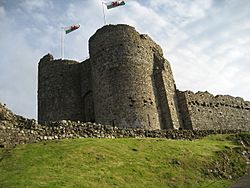Criccieth Castle facts for kids
Quick facts for kids Criccieth Castle |
|
|---|---|
| Castell Cricieth | |
| Part of Gwynedd | |
| Criccieth, North Wales | |

The remains of the great gatehouse at Criccieth Castle.
|
|
| Coordinates | 52°54′58″N 4°13′57″W / 52.916°N 4.2325°W |
| Type | Enclosure Castle |
| Site information | |
| Controlled by | Cadw |
| Condition | Ruinous |
| Site history | |
| Built | c.1230-1280s |
| Built by | Llywelyn the Great Llywelyn ap Gruffudd James of St George |
| In use | Open to public |
| Materials | Siltstone |
| Events | Welsh Wars Prince Madoc's Rebellion Owain Glyndŵr rebellion |
|
Listed Building – Grade I
|
|
Criccieth Castle (Welsh: Castell Cricieth) is an old Welsh castle. It stands on a rocky piece of land between two beaches in Criccieth, Gwynedd, in North Wales. From the castle, you can look out over Tremadog Bay.
The castle was first built by Llywelyn the Great, a powerful Welsh prince. But it was changed a lot later. This happened after English soldiers, led by King Edward I, took it over in the late 1200s.
Contents
Building the Castle: How it Changed Over Time
The stone castle started being built around the 1230s. It went through three main building stages. There were also several times when parts were updated.
Llywelyn the Great's Design
The oldest part of the stone castle is the inner ward. This was started by Llywelyn the Great. Unlike many other Welsh castles, Criccieth's inner ward had a special gatehouse. This gatehouse had two D-shaped towers. It was protected by a strong gate and a portcullis (a heavy metal grid that could be lowered). There were also "murder holes" in the passage. These were openings in the ceiling to drop things on attackers. Each tower also had arrowslits for archers to shoot from. This design might have been copied from English castles like Beeston Castle or Montgomery Castle. The gatehouse towers were used for living in. Their height was made taller later by the English. The castle's well was also inside the gatehouse passage. It got its water from a natural spring.
Llywelyn ap Gruffudd's Additions
In the 1260s or 1270s, more parts were added. This was during the time of Llywelyn ap Gruffudd, another Welsh prince. An outer area, called an outer ward, was built. A new gateway was added to the outer wall. This gateway had a large, two-story rectangular tower. The castle now had two circular lines of defense. This made it very strong, even if it wasn't a true concentric castle (a castle with walls inside other walls).
English Changes After Capture
English forces took Criccieth in 1283. After this, James of Saint George, a famous castle builder, made more changes. He might have built another two-story rectangular tower. This tower was connected to the rest of the castle by a wall. It was called the "Engine Tower" and is now in ruins. It might have been a base for a siege engine (a large war machine). The main gatehouse had another story added. Several Welsh towers were also made stronger. An outer barbican (a fortified entrance) was added to the outer wall.
When the Welsh owned the castle, the main living area was in the southwest tower. But when the English took over, people lived in the D-shaped gatehouse towers. Wooden buildings, including a large hall, were built inside the inner ward.
Castle History: Battles and Rebellions
Before the stone castle, there was an older type of castle called a Motte-and-bailey nearby. In 1283, King Edward I's English army captured the castle. It was then rebuilt by James of St George.
Madoc ap Llywelyn's Uprising
In 1294, a Welsh leader named Madoc ap Llywelyn started a rebellion against English rule. This uprising quickly spread across Wales. Several English towns were burned down. Criccieth Castle, along with Harlech Castle and Aberystwyth Castle, was surrounded by Welsh forces that winter. The people inside the castle managed to survive until spring. Then, new supplies reached them, and the siege ended.
Howell the Axe
In the 1300s, a famous Welsh constable (the person in charge of the castle) lived at Criccieth. His name was Hywel ap Gruffydd, also known as Howell the Axe. He fought for King Edward III of England. He was part of the famous Battle of Poitiers in 1356.
Owain Glyndŵr's Rebellion
The castle was used as a prison for a while. But in 1404, Welsh forces captured it again. This happened during the rebellion led by Owain Glyndŵr. The Welsh then tore down parts of the walls and set the castle on fire. You can still see burn marks on some of the stones today.
Criccieth Castle was also a place that inspired a famous artist. Joseph Mallord William Turner, a Romantic artist, used it in his paintings. He created a series of artworks showing sailors who had been shipwrecked.
Criccieth Castle Today
Today, Cadw looks after Criccieth Castle. Cadw is the Welsh government's historic environment service. The castle has exhibits and information about Welsh castles. You can also learn about Gerald of Wales, a writer from the 1100s.
Constable of the Castle
The person who was the constable of Criccieth Castle was also the Mayor of Criccieth. This meant they had two important jobs at once.


